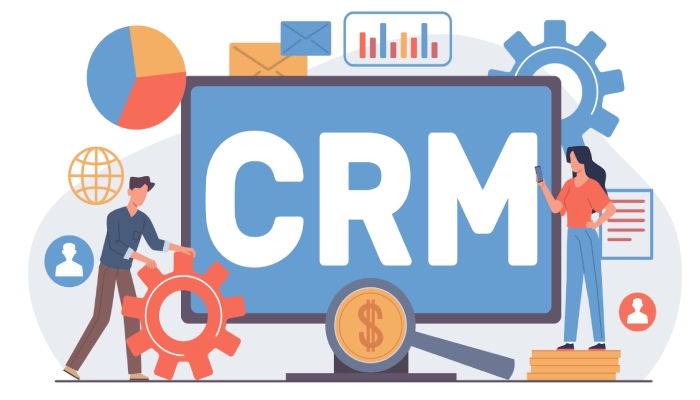The Best Email Outreach Tools for Successful Marketing Campaigns
In the fast-paced world of digital marketing, email outreach remains a powerful tool for connecting with potential customers. But let’s be honest—crafting that perfect outreach can be both an art and a challenge. Imagine sending dozens of emails only to hear crickets in response! To avoid this frustrating scenario, using the right email outreach tool is essential.
These tools not only streamline your process but also elevate your campaigns by enhancing personalization and tracking engagement. In this article, we’ll dive into some top email outreach platforms that can make your marketing efforts more effective and bring those leads closer to becoming loyal customers. So, whether you’re just starting or looking for advanced capabilities, let’s find the right fit for your needs!
The best email outreach tools include platforms like Close, Outreach, and Mailshake, each offering unique features such as automation, personalization, and follow-up capabilities to enhance lead generation effectiveness. Depending on your specific needs—like scalability or advanced analytics—you may find one tool more suitable than others for optimizing your cold email campaigns.

Top Email Outreach Tools
Let’s begin with Gmass, a favorite among users who seek seamless integration with Gmail. Designed specifically for mail merge outreach, Gmass simplifies sending personalized emails in bulk while maintaining individualization, which is key in cold emailing.
It offers intriguing features like a Chrome extension for easy onboarding, A/B testing for optimal performance, and its unique Spam Solver feature that boosts email deliverability. Users rave about its affordability, starting at just $25 per month. However, one must consider it requires extensive permissions and lacks built-in lead-finding capabilities. Yet, those willing to navigate these aspects often find value in its analytics dashboard that fortifies their outreach efforts.
Moving forward, we come across Apollo, a comprehensive sales platform that blends email outreach with other significant sales functions. Apollo stands out not only for its AI-supported email sequence building but also for its integrations with major CRM platforms like Salesforce and HubSpot. One noticeable advantage is its forever free plan, allowing 100 credits per month—ideal for small startups or teams testing the waters.
Yet, be cautious; some users find its interface complex and daunting at first glance, which could deter beginners. Those opting for paid plans should take note of how limited sender email addresses may restrict their outreach capacity.
If user experience is paramount to you, then Saleshandy deserves a mention as it focuses exclusively on email outreach with an intuitive design that streamlines campaign creation. Its automated sequences enable users to set forget follow-ups effectively while the unlimited email sender feature ensures scalability even in paid tiers—a win for growing businesses.
Another innovative tool is Saleshandy’s Content Guide; this unique feature analyzes emails and scores them to optimize performance before hitting “send.” Nonetheless, it’s worth noting that while Saleshandy has distinct advantages, it currently does not include LinkedIn automation or phone dialing features, which some rivals might offer.
As seen from these tools—Gmass, Apollo, and Saleshandy—they each provide different strengths and weaknesses tailored to specific user needs and marketing campaigns.
Considerations When Choosing Tools
Before diving into any tool, contemplate what matters most for your outreach campaign. User experience can be critical; a platform like Gmass offers easy onboarding that’s ideal if you’re just starting out.
Then consider the feature set—is lead finding vital for you? Some tools flourish in that arena while others excel at advanced analytics based on the size of your operations. Lastly, pricing models also play a crucial role; some tools provide generous free plans while others demand upfront investment—which might stretch your budget.
Thoughtfully evaluating your requirements against the array of email outreach tools available will guide you towards the perfect fit for your campaign goals and enhance your overall marketing effectiveness.
With this foundational understanding of outreach tools, let’s explore the essential attributes that will help sharpen your choice further.
Key Features to Consider

When evaluating an email outreach tool, it’s essential to focus on its core components that contribute to the overall success of your campaigns. One vital feature is automation. Automation takes away the repetitive aspects of email outreach; it handles everything from customizing emails to sending them at optimal times without requiring any manual intervention.
Imagine having a tireless virtual assistant crafting and dispatching emails while you focus on other strategic tasks. This feature not only saves you time but also ensures that your outreach remains consistent and efficient.
For those who might be skeptical, think about how automation can invoke a sense of persistence in your outreach efforts. Without it, valuable leads may slip through the cracks simply because follow-ups weren’t sent promptly or weren’t sent at all due to human error.
Integration
Integration is another crucial piece of the puzzle. Picture yourself at a grand feast with multiple dishes laid out before you, yet everything works best when you have a single plate that harmonizes all flavors together.
A good email outreach tool should integrate effortlessly with your existing email providers and collaboration platforms like Gmail or Salesforce. This seamless connectivity minimizes disruptions and allows you to streamline communications without toggling back and forth between different applications.
Seek out tools that promise smooth integration capabilities; they not only enhance function but also save precious hours that could otherwise be spent manually importing contacts or duplicating tasks.
Personalization
Another essential aspect is personalization. It’s no secret that consumers tend to ignore generic messages; dynamic insertion of recipient names and relevant information into your correspondence signifies attention to detail and increases engagement rates. Statistics show that personalized emails boast much higher open and response rates than their generic counterparts, making this feature indispensable for effective outreach.
This personal touch can range from inserting names to tailoring information based on previous interactions or preferences observed from customer data. When recipients feel like they’re receiving mail tailored specifically for them, they’re more inclined to respond positively—even if only out of curiosity. Hence, prioritize tools that offer robust personalization features so your communication resonates with each unique recipient.
Follow-Up Capabilities
The follow-up capabilities of your chosen tool also play a significant role in maximizing response opportunities. Implementing automated follow-ups based on specific triggers can significantly increase the likelihood of getting replies from potential leads. Think about it: if someone didn’t respond to your first email, prompting a gentle reminder could rekindle their interest without sifting through hundreds of messages manually.
According to recent findings, campaigns utilizing automated follow-ups enjoy higher reply rates compared to those lacking such features, helping keep engagement alive over the long term.
With a clear understanding of these fundamental elements—automation, integration, personalization, and follow-up capabilities—the path forward opens up even more possibilities for optimizing your marketing approach.
Best Tools for Automation

When it comes to optimizing your email campaigns, finding the right automation software is absolutely key. A good automation tool does more than just send emails; it helps build relationships with your audience by delivering the right message at just the right moment. This can significantly improve your campaign success rates while also saving precious time. For instance, businesses utilizing email automation engage their users better and generate twice as many leads compared to those who do not.
Mailshake
One of the notable players in this space is Mailshake, which shines for its strong automation features. With a starting price of $83 per month for its Sales Engagement Plan, it offers comprehensive capabilities, such as email sequencing and personalization tokens. These features allow marketers to craft unique messages tailored to each recipient, elevating engagement far beyond simple blast emails.
Additionally, Mailshake’s A/B testing functionality enables businesses to experiment with different approaches and hone in on what resonates most with their audience.
A user review highlights, “I like that I manually enter a contact…,” pointing out how customizable and user-friendly the platform is. This makes it an excellent choice for both newbies and seasoned marketers alike.
QuickMail.io
Then there’s QuickMail.io, another fantastic option focusing on high-level automation capabilities. Priced around $49 per month, QuickMail offers essential features like setting sending schedules and automatic follow-ups. This allows you to set up a sequence of emails sent depending on specific triggers, effectively nurturing leads over time without manual monitoring.
It streamlines your outreach efforts while ensuring consistent messaging—an essential factor in maintaining engagement with potential customers.By automating follow-up messages, QuickMail reduces the likelihood of important conversations slipping through the cracks—a common pitfall in manual emailing.
While both tools excel at providing robust automation solutions for email outreach, their integration capabilities with other platforms further enhance their utility. Exploring how well these tools connect with your existing systems will amplify your marketing efforts and streamline overall operations.
Integrating with CRM & Marketing Platforms

Integration is more than just a buzzword; it’s essential for making your email outreach effective and efficient. A well-integrated system allows all your data to flow seamlessly between different tools, ensuring that you have a comprehensive view of customer interactions, engagement history, and overall marketing performance.
Imagine having your email outreach platform synchronize effortlessly with your customer relationship management (CRM) software. This means that any information gleaned from your email campaigns can immediately update contact records in your CRM, eliminating time-consuming manual entries and potential errors.
A tool like Mixmax, for instance, showcases what effective integration can achieve. With robust connections to platforms like Gmail, Salesforce, and Slack, it enhances communication and collaboration among team members. Visualize this synergy: as soon as you send an outreach email through Mixmax, details log into Salesforce without additional steps, keeping everyone on the same page—allowing sales development representatives (SDRs) and account executives to focus on strategizing rather than data entry.
“Simplifying our processes has streamlined productivity tremendously,” a satisfied user remarked about the impact of such integrations on their workflows.
Furthermore, seamless integration improves reporting accuracy. By collating data from various touchpoints—emails opened, links clicked, responses received—marketers can create detailed reports easily. These insights feed directly back into decision-making processes, helping tailor future campaigns based on actual performance metrics rather than guesswork. You want to know what resonates with your audience; integrated systems help reveal those patterns effortlessly.
As you consider email outreach tools, think about how they integrate with existing platforms you utilize. Ask yourself whether the tool supports the kind of workflows you need and enhances collaboration across departments. Look for flexibility in customization options that accommodate unique business needs without forcing changes to established processes.
While integration is key for functionality, it also safeguards the quality of customer interactions and ensures valuable insights are not overlooked. Recognizing these dynamics will open the door to personalized approaches that better serve your audience’s needs.
Customization and Personalization Options

Customization is the secret ingredient that turns a generic email campaign into a tailored conversation with your audience. The beauty of modern email outreach tools is their ability to personalize emails beyond just inserting a name. For example, imagine receiving an email that knows not only your name but also your recent purchases or local weather conditions; these touches make the communication feel intimate and relevant.
A platform like Lemlist truly shines in personalization, offering unique features that allow users to infuse their emails with custom images, personalized videos, and tailored text based on recipient data. This might seem trivial, but statistics show that such personal touches can significantly increase open rates and engagement. In fact, emails with personalized subject lines are 26% more likely to be opened; that’s no small number when you’re trying to engage potential leads.
The richness of personalization can also extend into dynamic content blocks—this means different recipients can see different content within the same email based on their interests or demographics. By leveraging segmentation options in your email tool, you can target specific groups with tailored messages, increasing both relevance and response rates.
Building on this idea of customization, it’s essential to discuss how these visual elements can enhance user experience and foster stronger connections with your audience.
Visual embellishments should not be overlooked as they play an important role in capturing attention. By customizing aspects such as color schemes, fonts, and layouts to reflect your brand identity, you create an immediate connection with recipients.
Consider what resonates best with your target audience: would they prefer a minimalist layout or something vibrant loaded with graphics? The freedom to tweak these elements will make your emails instantly recognizable and memorable.
Imagine if every single marketing message felt like it was crafted just for you. How more engaged would you feel as a customer?
This sense of ownership is what true personalization aims for; it encourages loyalty and invites conversation. Move beyond the basic first-name greeting and explore the array of customization features offered by various email marketing tools. Every little detail contributes to building relationships that lead to conversions.
As we shift focus to the next critical aspect of successful campaigns, it’s worth considering how insights from analytics can refine your outreach strategies and drive better results.
Evaluating Campaign Analytics

Understanding how well your campaign is performing hinges on robust analytics. These insights not only shed light on the effectiveness of your outreach but also guide your future marketing strategies. By examining key metrics, you can pinpoint strengths in your communications while identifying areas that require improvements.
To illustrate, metrics like open rates reveal how compelling your subject lines are, while click-through rates offer a glimpse into the relevance and engagement provided by your email content. Analyzing these data points provides actionable intelligence.
For example, a low open rate might indicate the need for more enticing subject lines or optimal send times. Conversely, high click-through rates paired with low reply rates may signify interest without deeper engagement, prompting a rethink of your call-to-action (CTA).
Key Metrics to Monitor
Let’s explore some vital analytical components to monitor during your campaigns:
- Open Rates: This metric shows the percentage of recipients who opened your emails compared to those sent. A high open rate typically means that your subject line resonated with your audience.
- Click-Through Rates (CTR): This reveals the percentage of people who clicked on links within the email—an essential indicator of content engagement.
- Reply Rates: While it may seem less significant, tracking replies can indicate whether your audience feels compelled to engage further after reading.
- Unsubscribe Rates: Monitoring unsubscribes helps gauge overall audience satisfaction and content relevance. A sudden spike can signal that immediate adjustments are needed.
Each of these metrics offers a piece of the puzzle regarding how effectively you’re reaching your audience. Incorporating this data into a comprehensive analysis allows for strategic planning.
Reporting Tools and Features
The right tools can significantly ease the process of gathering and interpreting data. Take Domo; its cloud-native platform integrates various data sources and offers real-time dashboards that make trends easier to spot. Google Analytics provides invaluable insights into user interactions and website traffic patterns if you’re linking emails to sites. Mixpanel excels at event-based tracking, particularly valuable for Software as a Service(SaaS) businesses analyzing user engagement over time.
| Tool | Key Analytics Features | Starting Price |
| Close | Sales funnel reports, open/click rates | $9/month |
| Outreach | Advanced analytics, detailed reports | Hidden pricing |
| Smartlead.ai | AI-powered analytics, deliverability stats | $33/month |
Having the right tools enhances your ability to interpret key data points effectively; however, understanding why each metric matters drives success in your campaigns.
Regularly evaluating these analytical insights empowers you to adjust both content and strategy dynamically. It’s about weaving together storytelling with numbers—a narrative that helps yours stand out in crowded inboxes and cultivate long-lasting customer relationships.
As we consider various ways to optimize campaigns further, let’s look into specialized solutions tailored to meet diverse business needs.
Recommendations for Various Business Needs

For startups, having a tool that fits within a limited budget while providing essential functionalities is crucial. This is where Close shines, combining customer relationship management (CRM) with email outreach features. It enables startups to manage their communications effortlessly and concentrate resources on growth and innovation.
With pricing starting at just $9 per month when billed annually, it’s an accessible option for teams looking to scale their outreach without breaking the bank. An additional bonus is its customizable email templates and automated workflows tailored for follow-ups, allowing startups to maintain a personal touch while still being efficient.
Transitioning from startups to small businesses reveals some distinct differences in operational requirements.
For small businesses, the focus often turns toward enhancing deliverability and analyzing engagement effectively. Smartlead.ai serves this purpose well. Priced at $33 a month, it leverages AI technology not only for improved deliverability but also for valuable analytics that highlight areas ripe for optimization.
This dual focus helps small businesses ensure that their emails land in inboxes rather than spam folders—an often-overlooked hurdle that can lead to lost opportunities. Plus, the automated list-cleaning feature keeps your outreach efforts relevant and clean, further maximizing campaign effectiveness.
The other end of the spectrum brings us to enterprises, which have completely different dynamics when it comes to email outreach.
For enterprises, where complex communication strategies are the norm, Outreach stands out as a powerhouse tool designed for demanding environments. Although the exact pricing may vary based on specific needs, its advanced analytics and automation capabilities are invaluable for massive sales teams trying to coordinate efforts across departments or geographies.

This tool doesn’t just help you send emails; it also provides deep insights into engagement patterns, allowing companies to tailor their outreach based on real-time data—effectively aligning strategies with consumer behavior trends for optimal results.
Ultimately, choosing the right tool is about more than just picking from what’s available; it’s about deeply understanding the unique challenges each business faces.
By matching the right tool to your needs—whether you’re a budding startup needing affordability, a small business striving for improved deliverability through AI capabilities, or an enterprise requiring robust analytics—you can maximize not only your reach but also the impact of your email outreach campaigns. With platforms like Nureply, each step in this process brings you closer to establishing meaningful connections and driving growth, ensuring that every click translates into genuine engagement.
In summary, selecting the right email outreach tool is vital for successful marketing campaigns across various business sizes and needs. By understanding what each phase demands, you set yourself up for greater success in your outreach initiatives.



